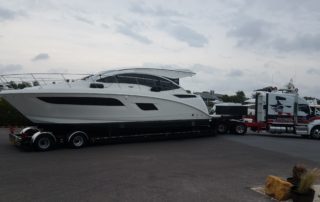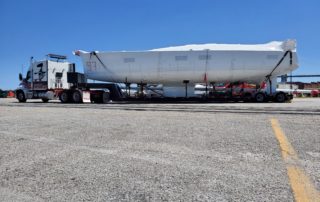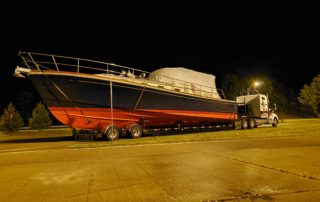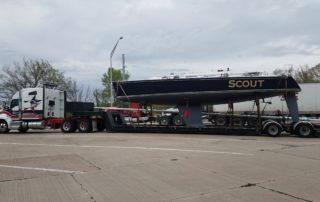Taking a few extra minutes to do some important research and be informed prior to your boat move may potentially save you quite a bit of stress and money during the actual transport.
IMPORTANT TIPS FOR HIRING A BOAT HAULER:
To most people their decision is strictly based on price. Other, TV shows glorifying the business by allowing many unqualified and illegal drivers to compete for the transporting of your boat. These are just a couple reasons why there has been a steep increase in horror stories lately in the trucking industry.
Being informed is the best way to weigh your options and choose the correct boat hauler for you.
Below is a lists of tips and advice from U.S. Boat Haulers LLC to assist in informing potential customers on what to look for in choosing an individual to transport your boat.
- Verify that the company or driver is a legal hauler. What do we mean by this? You should check their DOT Motor Carrier Number and Insurance. To do this, go to the https://safer.fmcsa.dot.gov website, then type in their DOT# or MC# in the space provided. My DOT# is 2821517 and my MC# is 940942. If they are a legitimate hauler, their file will have “active” beside their authority status and their insurance will be on file. If it says either “inactive” or “none” next to their authority status then they are completely illegal to be hauling anything no matter how they try to explain or excuse it away.
- If you’ve decided to try a Boat Transport Broker, then you should make sure that their broker authority is “active” and bond is on file. Most people would be shocked to find out how many Boat Transport Brokers are operating with either inactive or no authority at all. If they cannot keep their business and licenses up-to-date and legal then how would you expect them to hire a legitimate hauler to move your boat?
- If you plan on using an Online Bidding or Auction style website to request bids from different haulers then it is imperative that you verify the shipper’s authority and insurance prior to accepting any bids. These sites DO NOT check the status of their members, and will let anyone bid on these auctions. Just because someone is placing a bid on your boat move does not mean that they are a legal or capable transporter or have the correct equipment to do the trip. It is up to you to protect yourself by verifying their information. Make sure that the Motor Carrier Number matches the shipper’s name or DBA information. Some of these websites have increasingly become a target for criminals and the results have been devastating to the boat owners. Anyone can take another company’s MC# and type in next to their name to look legitimate.
- We recommend that you hire a company that accepts Credit Cards or various forms of payment besides cash. If a company only accepts cash as payment, then this should send up some huge warning flags. First, this is a good sign that they are not a legitimate, legal transporter. Secondly, they usually don’t want a shipper to have any leverage against them in the case that any claims or damage arise during the trip.
- Don’t get suckered by a low-ball quote. Prices in this industry have a tendency to fluctuate based on the season. The summer months are considered the prime season whereas the winter months are considered the slow season. To save yourself some money you might consider having your boat transported during the winter. Transport prices are generally based on the miles from origin to destination and the size and weight of the boat being transported. Really low prices should send up a lot of red flags that something is either wrong with the company or their equipment or perhaps they have inadvertently left something out. You get what you pay for and cheapest is usually not the best option. Proceed with caution and research the company and their references.
- Do not try to cut costs by avoiding ordering permits or hiring escorts when moving your over-dimensional boat. Any company that attempts to do this is an extreme liability to their clients. If the beam of the boat is greater than 8’6″ wide, or the boat on the trailer is greater than 13’6″ high (in most states) then it is considered an oversized load. All states require permits on oversized loads but each state is different on what their requirements are pertaining to when and how many escorts may be needed. Make sure that your boat will be hauled legally.
- Another option which a lot of shippers do is check into the boat transport company with the Better Business Bureau. Most reputable haulers are members with the BBB. If they are not listed with them, then ask the transporter to provide you with references from recent customers or marinas that they have moved a comparable boat for or to. Then contact them to verify the companies reference.
PREPARING YOUR SAILBOAT FOR TRANSPORT:
The following information is provided so that you may have a better understanding of what is involved when packing and preparing a sailboat to be transported over long distances. It is very important to understand that once loaded on the trailer, the sailboat will be moving at highway speeds, and the truck may encounter head or cross winds in excess to traveling speeds which could result in over 100mph over the deck. Also rain, snow, hail and inclimate weather are common occurrences. The boat itself can handle such conditions, but accessories such as canvas, mast rigging, electronics and the like are not able to with stand the effects of the elements. With the foregoing in mind, we recommend the following steps when packing your boat for transporting.
MAST
- Remove all shrouds, stays, spreaders and external halyards. Mark them and pack them inside the boat.
- Remove antennas, wind instruments, mast headlights and the like.
- Coil wire rigging singly and mark and store in boat.
- Coil rod rigging and mark. It will be stored on the bed of the trailer.
- Internal halyards should be removed. If they are left on they should be we wrapped and taped to the mast.
- Do not put the mast on top of the boat. There is a high degree of probability of bending the pulpits and or damaging hatches. We will carry them in special padded holders alongside the boat.
- Winches are normally ok to leave on. Larger boats may need them removed due to height.
PAINTED MASTS
(These need special attention as they are very susceptible to chaffing damage.)
- Wrap them well with at least two layers of bubble wrap or rug with the nap towards the mast. Do not use regular visqueen, it only holds out water and is to thin to prevent chaffing.
- Be careful not to allow any objects between the wrapping and the mast (i.e. shrouds, wires, ect.). Vibration can cause chaffing damage even through the padding.
EXCEPTION: ROLLER FURLING SYSTEMS These are best kept on the mast to avoid kinking. Pad the mast first, then lay the foil on the padding. If the mast is deck stepped it will probably shorter then the furling system. If so, insert a 2×4 or like piece of wood in the butt end of the mast long enough to extend the mast past the drum so as to support the furling and drum. Tape this all together padding the drum well. Tape every two feet or so down the mast to hold the foil firmly to the mast. Pad extra well where any winches, cleats or other items are on the mast. With a keel stepped mast, the furling system will be shorter then the mast, the extension as just described is not necessary. Where the drum hits the mast use extra padding between drum and mast.
HELPFUL HINT: When using duct tape, make the first wrap tight with the sticky side up away from the mast. Then make a couple of wraps with the sticky sides towards one another. This will help prevent the adhesive from pulling varnish or paint off of the mast and avoid the need to clean adhesive off the mast. Used rug can be obtained free from any carpet stores garbage bin.
DODGERS AND CANVAS
Remove dodger bows and canvas as well as any other exterior canvas and store below.
OUTBOARD MOTORS, DINGHY’S
- Remove the outboard motors and store inside.
- Dinghy’s should be removed from the cabin tops or davits. They can be carried on the poop deck of the trailer.
PERSONAL EFFECTS
Be aware you are shipping a boat and its contents ride along as extra baggage. Anything inside such as personal effects, electronic instruments, or other equipment is unknown to the carrier and such items are not insured.
CRADLES WHEN SUPPLIED, EXTRA CAUTION IS NEEDED
- The cradle must fit in the exact contour of the hull and be in good condition.
- The boat must be well secured to the cradle.
- Damaged caused by the cradle is not the responsibility of the carrier. We will however do everything possible to avoid or prevent damage from occurring.
MISCELANIOUS
- Stow the interior of the boat well. If drawers have a habit of opening, tape them shut. DO NOT leave anything loose inside. The boat will get a better ride on our air-ride trailers then in a storm, but if secured/packed as if in a storm, everything will ride well.
- Secure and lock all hatches, ports, windows, and the companionway.
- If there is any possibility of freezing (keeping in mind mountain passes) drain fresh water systems and the head. Also drain or antifreeze the engine.
- Cover all open screw holes with tape.
- Disconnect the batteries.
TRAILERS
- If the boat is on a trailer it must fit well and be well tied to the trailer.
- All attaching devices (winches, ropes, wire etc.) must be in good condition and able to secure the boat. Their failure is not the responsibility of the carrier. We will however watch these things and do everything possible to avoid and minimize any damage they may cause.
INSURANCE AND LIABILITY
By law, all boat transportation companies are required to carry cargo insurance. The maximum value carried by each varies greatly. Be sure the carrier’s maximum insurance coverage is greater than your boats value. If there is a loss, you are only entitled to the cost of repair or the boats actual value. Ask the carrier for specific coverage and policy exclusions. The can be very different. To get maximum coverage it is advisable to have a Transportation Rider attached to your yacht policy. The shipper needs to be aware that the carrier does not warrant the condition, integrity, craftsmanship, or packing of any part of the boat. Damage attributed to the above items as well as wind and weather damage is not covered by the carrier.
If you have any other questions I an happy to answer them for you. Please call Chris toll free at 888-224-1500 .
PREPARING YOUR POWERBOAT FOR SHIPPING:
The following information is presented so that you may have a better understanding of what is involved when packing and shipping a powerboat. It is important to understand that once loaded on the truck the boat will be moving at highway speeds of 55 mph or more, and that the truck may well encounter head or cross winds in excess of 50 mph. Resulting winds over the deck can exceed 100 mph. Rain, snow, hail, and like are common occurrences. The boat itself is ok for such conditions but accessories, ie. canvas, rigging, flying-bridge windshields, electronics and the like are not able to withstand the effects of these elements. With the forgoing in mine, we recommend the following steps be taken when packing the boat.
INTERIOR
- Put everything away as if you were going to be in a storm. Modern air-ride trailers give the boat a much better ride than when you are in a storm, but this is a good way to pack the boat. Doors, drawers, windows, portholes, hatches and the like should be taped shut. Secure and lock same.
- Disconnect the batteries
- If there is a possibility of encountering freezing temperatures (remember the mountains), drain the all fresh water systems and add antifreeze to the engine cooling system.
EXTERIOR
- Any canvas covers, or other exterior canvas must be removed and stored inside.
- Make sure all accessory items like horns, speakers, spotlights, etc. are well secured. If removed cover the screw holes with tape.
- Remove all items required by the carrier.
OUTBOARD MOTORS, DINGHYS
- Remove the outboard motor and store inside
- Dinghys will be removed from the cabin top, davits, or transom-step mounts and carried on the trailers poop deck.
PERSONAL EFFECTS
You are shipping a boat, it’s contents ride along as extra baggage. Anything inside such as personal effects, electronics, fishing gear etc. is ok. Just be aware the carrier is not insuring any interior items.
TRAILERS AND CRADLES
- If the boat is on a trailer it must fit well and be tied to the trailer.
- Cradles must fit the exact contour of the hull.
- All attaching devices (winches, ropes, wire, etc.) must be in good condition and able to secure the boat. Their failure will likely cause damage which is not the carriers liability.
- Damage caused by cradles, trailers, or attaching devices supplied by the shipper are not the responsibility of the carrier. We will however, do all we can to avoid or prevent damage caused by these items.
FLYING BRIDGES
- Flying bridges which are removed can be placed anywhere they fit well on the boat or on the poop deck of the trailer. If on the boat, pad the bottom of the bridge well with carpet then tie securely to the boat. If on the poop deck of the trailer a wood frame under the edges of the bridge are necessary to protect these edges.
- Remove the venturi windshield
- Tape over any screw holes.
SHRINKWRAP
This is a tough one. As a general rule we do not advise the use of shrinkwrap. If not properly wrapped with heavy mil material, well padded in sharp areas, it will probably rip in transit. If we cannot repair the rip (we carry shrinkwrap tape), we must remove it and throw it away. It will cause severe damage anywhere it is flapping in a very short period of time.
If you have any other questions I an happy to answer them for you. Please call Chris toll free at 888-224-1500 .
OTHER THINGS TO CONSIDER:
Measuring Your Boat For Transport:
When requesting a quote to transport your boat, the dimensions are extremely important. Please follow these guidelines for measuring your boat accurately. In order to transport your boat for the lowest possible price, boat transporters try to carry more than one small boat going in the same general direction at the same time. Or, if the boat is considered oversize, then they use these dimensions to get the most accurate quote for you based on the extra costs of fuel, State Permits, Pilot Cars, and sometimes even Police Escorts. That is why it is important for the boat transporter to know the full overall length, width, height, and weight of your vessel in order to know what boats will fit on the trailers.
OVERALL LENGTH: Include bow pulpits, swim platforms, outboard motor brackets, outboard motors themselves (the length of the motors or out drives in the raised position). If on a trailer, include from the tip of the tongue to the end of the motor.
OVERALL HEIGHT: The maximum height of many overpasses is 13 feet 6 inches. Many oversized yachts require wide-belly low-boy trailers in order for the keel to set down low. Using these type trailers for tall yachts can sometimes be low enough to avoid using a pole car if the boat loaded is less than the state-by-state height restraint (the New England area has many low bridges and re-routes may be dictated by the Department of Transportation. Boats with an overall height greater than 13.6′ loaded on the trailer require special handling and routing. It is critical to measure from the bottom of the keel to the highest non-removable part of the boat.
The draft (from the waterline to the bottom of the keel) + clearance (from the waterline to the highest part of the vessel) equal the total standing height. Pending on your model, if the fly or command bridge may need to be removed. It is important to measure the vessel without the bridge and also provide bridge dimensions to ensure appropriate transport space. Remember measure twice – cut once!!!
The bridge should be placed somewhere suitable on the boat and make certain it is safely secured. If it must be placed on the trailer, a frame should be prepared for it to rest upon. If your radar arch is removed, it should be secured against your boat. You might consider using carpet to protect areas where surfaces may “touch”.
Electronics such as radios, Loran Systems, etc., should be shipped separately or securely stowed in your cabin, with all cabin doors, windows, and any other access, locked.
OVERALL BEAM/WIDTH: The beam of your boat is the measured as the widest point of the boat including anything attached to the boat.
Routing:
If your boat is not considered oversize, then mapping software like MapQuest can be a good estimate of the mileage. Keep in mind that most trucks are restricted to travel on the highways, so please check that option on your routing program. If your boat is listed as oversize, then the general rule of thumb is to add an extra 25% onto the above listed approach for estimating the trip length. States require that oversize vehicles stay on the routing they list on the permit which always adds extra miles onto the move.
Ernst from US Boat Haulers was the perfect choice. He picked up my boat on time and delivered a day earlier than expected. Everything was professional and he kept me informed along the way. I would not hesitate to use him again for my next shipment. I can’t really say enough positive things about him. Top notch service and equipment.
On time pick up and delivery (1,100 miles), clear, concise, & consistent communications. Ernst is a professional in all areas. This is the first time I have shipped my boat since buying it in 2002. I had a lot of questions and all my questions were answered with politeness and patience. The truck and trailer are top notch and are obviously maintained to high standards. This was a seamless transaction and my experience was excellent.
I have never shipped a boat before and was not sure what to expect. It was a delightful surprise to meet Ernst. He is a sailor who loves boats. He was careful and meticulous in planning his trip and securing my boat. He worried about the boat more than I would have. He arrived to pick her up exactly when he said he would and delivered her in perfect shape exactly when he said he would. I cannot think of an aspect of my experience which does not deserve rave reviews.




